What You Missed at Our Innovation Workshop – and How You Can Get the Same Benefits
At the recent Frost & Sullivan Innovation Workshop and Tour in Chicago, SmartOrg hosted a powerful, interactive workshop that tackled one of the biggest challenges facing innovation teams: Why do so many exciting innovation projects fail during the Incubation phase? Spoiler alert: it’s not because the ideas are bad, it’s because they lack the right evidence to back a major investment decision. Sound familiar?
Here’s the truth: Incubation is where most innovation projects die, and it’s not because teams aren’t working hard. It’s because they’re often working on the wrong things! We know that the future of these projects is uncertain, but the question is, how do you turn uncertainty into opportunity? How do you keep your executives engaged without over-promising and under-delivering?
That’s exactly what our workshop aimed to solve!
So, What Did We Do?
This workshop was designed to use just some of the methods that SmartOrg has baked into its Innovation Navigator software, but we executed it in an analog format to great effect. So how did it play out? We didn’t waste time on theories – we dove right into a real-world example of a product being tested in the market today. Paul Campbell, one of our brilliant Thought Leaders, kicked things off by describing a new product his company recently introduced and laying out the baseline value of the opportunity, assuming that it will be moderately successful. How accurate was the baseline value? Truth be told, it actually doesn’t matter all that much. Arguing over the precision of the baseline value is a fool’s errand, because during Incubation, most business case assumptions are estimates that need to be tested and validated. A reasonable estimate of the project value is good enough for now.
We then talked about the importance of identifying key issues that could influence success or failure of a project. Think market share, competitive responses, regulatory hurdles – anything that could influence project value. With Paul’s guidance, we honed in on five key issues that could sway the project’s outcome in either direction, and asked him how each issue could resolve in his favor, and if it did, how much better the base case might be. We did the same exercise under the presumption that the issue did NOT resolve in his favor. Then, we figured out the “swing” for each issue – that’s the difference between best- and worst-case outcomes. And just like that, we had a crystal-clear map of which issues were responsible for the most uncertainty!
Introducing the De-Risk Dashboard – Your Innovation Game-Changer
Knowing that information about one project is powerful, as it provides a roadmap for what experiments to run to build confidence in the business case. Now imagine if you had these insights for every incubation project in your innovation portfolio? Our participants jumped right in to help make that happen. Each workshop group worked through the same process for their own project. For each project, each group wrote down the name and swing value for each issue on a Post-It note, which we then plotted on the wall in a format we call the De-Risk Dashboard. Imagine a visual map of your project portfolio – where you can literally see the range of uncertainty across all your projects compared to their baseline value, with visibility into the issues that matter most.
The Aha! moment for participants? It wasn’t just about tweaking the current baseline values, but rather about zeroing in on the big swings that could unlock massive upside potential (or stop disastrous downsides from unfolding). Projects that looked like long shots suddenly became worth investing in, while “safe bets” were revealed to be not worth the effort.

How Did Participants Define This Experience? They used words like “eye-opening” to describe the method, and a novel way to “reframe” their own incubation processes. The method showed how it promotes “curiosity” to explore “upside potential” and think of innovation projects as “opportunities” to explore and learn about rather than simply execute.
And the best part? Everyone walked away knowing how to turn uncertainty into a roadmap for success at both the project and portfolio level. No more guessing games. No more wasted effort on the wrong tasks. Just laser-focused priorities to push projects forward.
Wish You’d Been There?
Do you feel like you missed out by not being at this workshop? Don’t worry, we’re not leaving you behind. We created a four-page worksheet for the workshop, and we’d like to share it with you. Simply click the button below to get access and start putting this method and the De-Risk Dashboard approach to work today.



